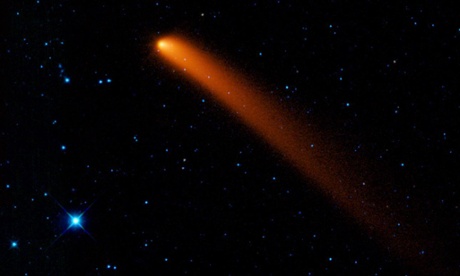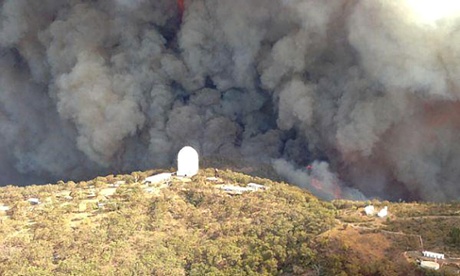
The program, which discovered the Siding Spring comet that narrowly missed Mars on Sunday, was shut down last year after losing funding.
"It's a real worry," Bradley Tucker, an astronomer at the Australian National University (ANU) and University of California Berkeley, told Guardian Australia.
"There could be something hurtling towards us right now and we wouldn't know about it."
The Siding Spring survey - named after the observatory near Coonabarabran in central New South Wales, where the Mars comet was first spotted - was the only program in the southern hemisphere actively searching for potentially hazardous comets, asteroids and meteors.
Celestial objects that pass within 7.4m kilometres of the earth, or which are more than 150 metres in diameter, are considered potentially hazardous asteroids (PHAs). There are 1,508 known cases. The most famous asteroid to have struck the Earth landed in Mexico about 65m years ago, and is believed to have caused or contributed to the extinction of the dinosaurs.
A 20-metre meteor entered the Earth's atmosphere undetected in 2013 and exploded spectacularly about 30km above Chelyabinsk in Russia, injuring 1,500 people.
"It's essentially like a nuclear bomb going off in the atmosphere," Tucker said. "These things can do inconceivable damage."
The Nasa-funded Australian survey discovered more than 15 objects, and was led by Dr Robert McNaught, a Scottish-Australian scientist credited with discovering about 475 asteroids and about 82 comets, including the Siding Spring comet - more than any other astronomer.

Appeals to the Australian government and local mining companies for a lifeline also went unheeded. "There's a lot of science that's hurting," Tucker said.
May's federal budget stripped the country's scientific research agency, the CSIRO, of $111m in funding, with more than 500 jobs expected to go.
Tucker said programs to track abandoned spacecrafts, flecks of paint and other space junk were still relatively well funded. But the Siding Spring telescope used by the program needs an expensive upgrade, and neither Canberra nor private donors were interested. "There's limited science money, and something always has to give," he said.
The Siding Spring survey's partner site in Arizona continues to operate, meaning northern hemisphere astronomers can keep their gaze trained on the objects coming from the northern galactic plane.
"But obviously the northern hemisphere cannot see objects in the southern sky," Ian Adams, an ANU astronomer, said.
"The comet that went past Mars, that was a southern hemisphere comet, it came from deep in the southern hemisphere's sky. The northern hemisphere would never have seen it."
The task of searching the southern galactic plane was now left to "amateurs and enthusiasts" with a decent telescope in the backyard, Adams said.
Tucker said the problem was that governments still saw comet and asteroid-spotting as an academic pursuit rather than an early-warning system. "The idea needs to switch from thinking of this as scientific research ... to seeing it as something no different to tracking cyclones," he said.
"It's about getting people out of harm's way, minimising damage. And it shouldn't be seen as one country's problem. It's a global problem."
China has experimented with using missiles to divert small meteors and man-made space junk, Tucker said.
Scientists at ANU received $60m funding earlier this year to develop another solution: lasers that could be beamed from earth to slow down or alter the orbit of space debris before it collided with Earth.



Quote: "There could be something hurtling towards us right now and we wouldn't know about it."
There is. Not hurtling quite yet but less than a million miles away. It should be here May +/- 3 months (2015). Hopefully it will just miss again this time.